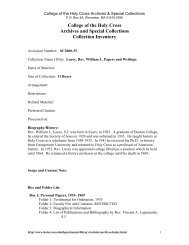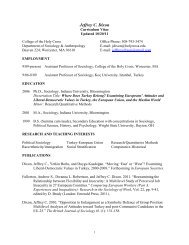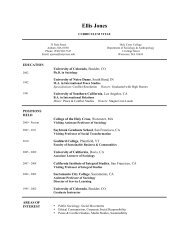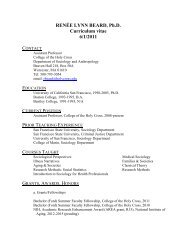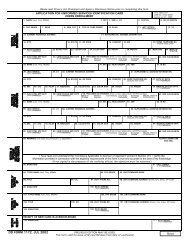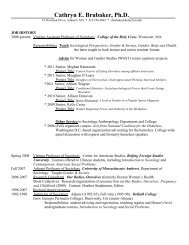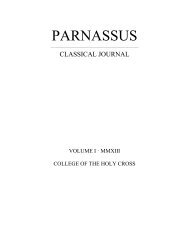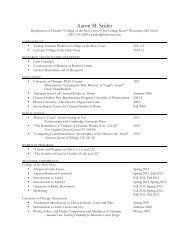Control of frequency in cricket song - The Journal of Experimental ...
Control of frequency in cricket song - The Journal of Experimental ...
Control of frequency in cricket song - The Journal of Experimental ...
Create successful ePaper yourself
Turn your PDF publications into a flip-book with our unique Google optimized e-Paper software.
energy at a number <strong>of</strong> additional frequencies. To amplify and<br />
filter the tegm<strong>in</strong>al signal, they proposed a tunable resonator<br />
consist<strong>in</strong>g <strong>of</strong> the subalar space and tegm<strong>in</strong>a. As with the fPFI,<br />
the tun<strong>in</strong>g <strong>of</strong> this ‘subalar–tegm<strong>in</strong>al resonator’ would be<br />
controlled by neural mechanisms. This resonator will be<br />
described <strong>in</strong> more detail below. To summarize their scheme<br />
briefly, they believed that a <strong>cricket</strong> listens to its <strong>song</strong> and then<br />
adjusts its fPFI and subalar–tegm<strong>in</strong>al resonance to produce a<br />
loud, pure-<strong>frequency</strong> signal.<br />
Let us consider the proposed subalar space–tegm<strong>in</strong>al<br />
resonator <strong>in</strong> more detail. Bailey and Broughton (1970)<br />
speculated that the subalar space (Fig. 1) might act as part <strong>of</strong><br />
a resonator <strong>in</strong> bush <strong>cricket</strong>s (Tettigoniidae). Follow<strong>in</strong>g their<br />
lead, Stephen and Hartley (1995b) proposed that a Helmholtzlike<br />
resonator operated <strong>in</strong> gryllids. This resonator would be<br />
able to amplify any fPFI, would filter out unwanted frequencies<br />
and would tend to entra<strong>in</strong> the fPFI to its resonant <strong>frequency</strong>. In<br />
many ways, what they proposed resembled the abdom<strong>in</strong>al<br />
resonator found <strong>in</strong> many species <strong>of</strong> cicada (Young, 1990;<br />
Bennet-Clark and Young, 1992).<br />
<strong>The</strong> physics <strong>of</strong> Helmholtz resonators is well-understood<br />
(Fletcher, 1992). A classic example is a jug or flask. <strong>The</strong> mass<br />
<strong>of</strong> air <strong>in</strong> and near the neck is free to move back and forth en<br />
masse and acts as an <strong>in</strong>ertance whose value is given as:<br />
L = ,<br />
ρl′<br />
S<br />
where ρ is the density <strong>of</strong> the air (kg m −3 ), l′ is the effective<br />
length (m) <strong>of</strong> the neck, which is equal to the physical length<br />
plus a correction factor, and S (m 2 ) is the neck’s cross-sectional<br />
area. <strong>The</strong> air <strong>in</strong> the jug’s reservoir acts as a compliance. S<strong>in</strong>ce<br />
it is conta<strong>in</strong>ed everywhere except at the neck, if force is applied<br />
either from the jug’s wall or via the air <strong>in</strong> the jug’s neck, the<br />
air <strong>in</strong> the reservoir will be compressed or rarefied but not<br />
displaced. This compliance, C (s 2 kg −1 ) is given as:<br />
V<br />
C = ,<br />
ρc2 where V is the volume (m 3 ) and c is the speed <strong>of</strong> sound (m s −1 ).<br />
If we substitute equations 2 and 3 <strong>in</strong>to equation 1, we obta<strong>in</strong><br />
the resonant <strong>frequency</strong> <strong>of</strong> a Helmholtz resonator <strong>in</strong> terms <strong>of</strong> its<br />
dimensions:<br />
<br />
c S<br />
f0 = .<br />
2π l′V<br />
This expression is valid provided that none <strong>of</strong> the dimensions<br />
is large compared with 0.1λ, where λ is the wavelength <strong>of</strong> f0<br />
(Fletcher, 1992).<br />
Although Stephen and Hartley (1995b) stated that their<br />
proposed resonator was ‘Helmholtz-like’, there are strik<strong>in</strong>g<br />
differences. In their subalar–tegm<strong>in</strong>al resonator, the <strong>in</strong>ertance<br />
is the mass <strong>of</strong> some portion <strong>of</strong> the tegm<strong>in</strong>a, and the air with<strong>in</strong><br />
the subalar space acts as the compliant element. However, note<br />
that this air is far from enclosed, and it is hard to imag<strong>in</strong>e how<br />
(2)<br />
(3)<br />
(4)<br />
<strong>Control</strong> <strong>of</strong> <strong>frequency</strong> <strong>in</strong> <strong>cricket</strong> <strong>song</strong><br />
587<br />
it could be compressed (Fig. 1). Nevertheless, they suggested<br />
that perhaps it was sufficiently conf<strong>in</strong>ed to act as a compliant<br />
element. <strong>The</strong>y derived an equation for the resonance <strong>of</strong> the<br />
proposed system essentially by substitut<strong>in</strong>g equation 3<br />
(compliance <strong>of</strong> a volume <strong>of</strong> air) <strong>in</strong>to equation 1:<br />
<br />
c ρ<br />
f0 = ,<br />
2π LV<br />
where <strong>in</strong> this case the <strong>in</strong>ertance, L, is the tegm<strong>in</strong>al mass<br />
expressed <strong>in</strong> acoustic units (kg m −4 ). Note that the value <strong>of</strong> f0<br />
for both their model (equation 5) and a Helmholtz resonator<br />
(equation 4) can be altered by chang<strong>in</strong>g the subalar or reservoir<br />
volumes. Thus, Stephen and Hartley (1995b) suggested that<br />
<strong>cricket</strong>s could simply change the spread and elevation <strong>of</strong> their<br />
tegm<strong>in</strong>a to alter f0 <strong>of</strong> the subalar–tegm<strong>in</strong>al resonator.<br />
For reasons that are not clear, Stephen and Hartley used<br />
equation 4 (Helmholtz resonator), not the equation they<br />
derived for their system (equation 5), to make important<br />
predictions about the subalar–tegm<strong>in</strong>al resonator. <strong>The</strong> most<br />
important <strong>of</strong> these predictions is that f0 for a Helmholtz<br />
resonator will shift if the vessel is filled with gases that have<br />
different values <strong>of</strong> the speed <strong>of</strong> sound, c. This can be<br />
accomplished by fill<strong>in</strong>g the chamber with gases <strong>of</strong> differ<strong>in</strong>g<br />
densities s<strong>in</strong>ce:<br />
γP0<br />
c = , ρ<br />
where γ is the dimensionless ratio <strong>of</strong> specific heats and P0 is<br />
the pressure <strong>in</strong> the absence <strong>of</strong> any sound. Stephen and Hartley<br />
(1995b) attempted to use this phenomenon to prove the<br />
existence <strong>of</strong> their proposed resonator by expos<strong>in</strong>g call<strong>in</strong>g G.<br />
bimaculatus to a mixture <strong>of</strong> helium, oxygen and room air<br />
(‘heliox-air’). <strong>The</strong> fC <strong>of</strong> the result<strong>in</strong>g calls <strong>in</strong>creased by 1.05to<br />
1.10-fold, far less than the 1.35-fold <strong>in</strong>crease expected if the<br />
subalar volume was part <strong>of</strong> a Helmholtz-like resonator that<br />
entra<strong>in</strong>ed the fPFI (equation 4). However, <strong>in</strong>stead <strong>of</strong> reject<strong>in</strong>g a<br />
role for the subalar space, they chose to <strong>in</strong>terpret the smallerthan-predicted<br />
fC shift as be<strong>in</strong>g caused by distortions with<strong>in</strong> the<br />
auditory system. Paradoxically, they had used this same<br />
<strong>in</strong>terpretation previously to expla<strong>in</strong> a decrease <strong>in</strong> the most<br />
energetic <strong>frequency</strong> produced by a bush <strong>cricket</strong> call<strong>in</strong>g <strong>in</strong><br />
heliox (Stephen and Hartley, 1995a). Presumably, they<br />
believed that the gas fill<strong>in</strong>g the tympana <strong>of</strong> G. bimaculatus was<br />
different from that <strong>of</strong> the general atmosphere, perhaps because<br />
<strong>of</strong> the high levels <strong>of</strong> metabolic CO2. In any case, to support<br />
their proposed subalar–tegm<strong>in</strong>al resonator, they constructed a<br />
model system. However, this model did not resemble the<br />
situation <strong>in</strong> <strong>cricket</strong>s <strong>in</strong> one critical aspect: it used an essentially<br />
closed cavity as an analog to the very much open subalar space<br />
(Fig. 1).<br />
For these reasons, the present study set out to test<br />
experimentally the major features <strong>of</strong> Stephen and Hartley’s<br />
(1995b) model. First, we repeated their <strong>in</strong>vestigations <strong>of</strong> pulseto-pulse<br />
variation <strong>in</strong> fC and <strong>of</strong> fC shifts <strong>in</strong> heliox-air mixtures.<br />
Next, we compared <strong>frequency</strong> shifts <strong>in</strong> the free resonance <strong>of</strong><br />
(5)<br />
(6)



